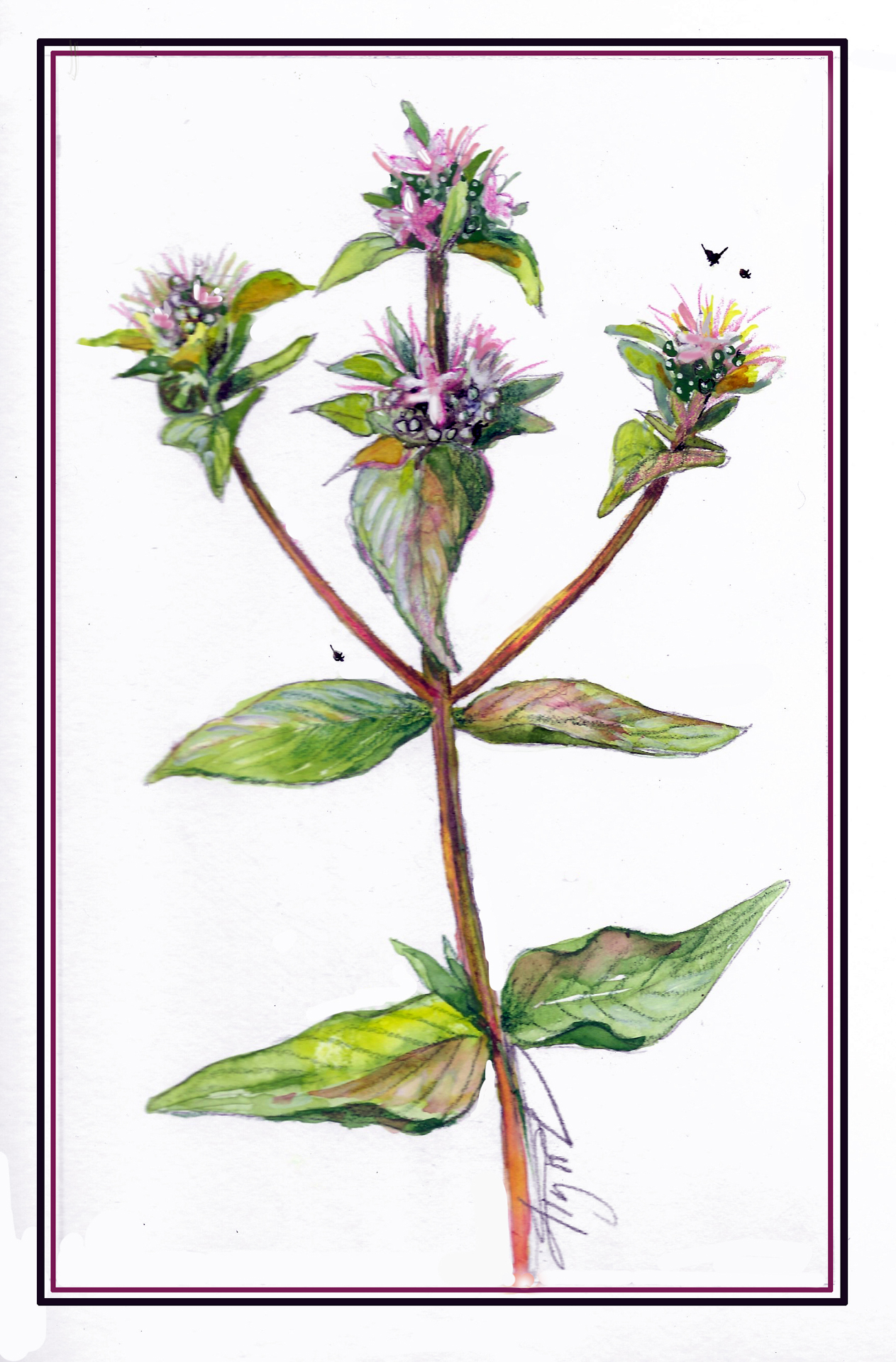Behind my garden of native plants, one scrappy perennial holds its own among the tangle of goldenrod stalks and blackberry brambles. Its swaying flowerheads buzz with a throng of insects: golden digger and great black wasps, bumblebees, sweat bees, butterflies, and beetles.
This pollinator magnet is mountain-mint. It hails from the same family, Lamiaceae, as the “true” mints commonly planted in herb and kitchen gardens, and it shares their characteristic minty aroma and taste. But while most true mints (genus Mentha) originate overseas, our region’s mountain-mints (genus Pycnanthemum) are native.
Six species of mountain-mint grow in the Northeast. Of these, four can be found in the upper Connecticut River valley: Pycnanthemum incanum, P. virginianum, P. tenuifolium, and P. muticum. Bob Popp, former state botanist of Vermont, noted that P. incanum and P. muticum are rare in Vermont and New Hampshire, with P. incanum listed as endangered in both states and P. virginianum classified as endangered in New Hampshire.
When it comes to preferred habitat, “mountain-mint” is a bit of a misnomer. As opposed to the alpine settings suggested by its common name, Popp said that Pycnanthemum species tend to populate lowland environments such as meadows, fields, and sunny openings in forests. “Pycnanthemum species occur in open areas; they don’t occur in dense woods,” he said. “The species P. muticum in particular seems to have an affinity for utility corridors.”
This preference for open habitats, which are often targets of development, helps to explain why some Pycnanthemum species are threatened in the region. Popp also pointed out that northern New England’s colder temperatures act as a natural limit on mountain-mints’ distribution at higher latitudes.
Because they share the true mints’ signature aroma and flavor, mountain-mint leaves can be used for similar purposes, such as enhancing meals and drinks and flavoring medicines. Arthur Haines, a senior research botanist at the Native Plant Trust, explained that both mountain-mint and its true mint relatives attain their well-known fragrance and flavor from aromatic compounds called terpenes and noted that mountain-mint’s pungency serves important defensive and biological functions.
“There are a variety of pathogens and herbivores that would infect or consume these plants if it were not for these defensive compounds,” Haines said. “These terpenes, which are particularly strong in mountain-mints, have an array of benefits, including antiseptic and antimicrobial actions that keep them safe from bacteria, fungi, and viruses. The strong flavor may also act as a feeding deterrent for some herbivores.”
He added that one terpene found in mountain-mint, pulegone, is a common ingredient in insect repellants.
While the terpenes extracted from mountain-mint leaves can be used to repel insects, its flowers attract them. The small, tubular blossoms are pink, lavender, or white, depending on the species. They bloom at the end of 2- to 6-foot-tall stalks from July to September in the Northeast, providing pollinators with a critical source of late-summer forage. According to a 2021 paper in the journal Ecological Applications, mountain-mint is among a group of native perennials that produce comparatively high quantities of nectar, which helps to explain its irresistibility to insects. In fall, the stalks and seedheads dry out and persist through the cold months, offering winter shelter for various wildlife and nesting material for migratory birds when they return in spring.
For the ecologically minded gardener, Pycnanthemum species are a must-have. Once established in partial or full sun, they will form dense patches that require minimal care. Their strong smell deters deer and other browsers. And because many species of predatory wasp frequent mountain-mint, its presence in the garden can facilitate natural pest control when cultivated near crops.
The one potential drawback of mountain-mint — depending on the aims of the gardener — is its zeal to expand. Like many of the true mints, mountain-mint spreads via rhizomes; certain species, including the one I have in my garden, P. muticum, do so with particular enthusiasm. As such, make sure you establish Pycnanthemum in an area where it has room to colonize its immediate neighborhood. Otherwise, you’ll need to continually pluck the new shoots when they break through the soil to keep the original planting contained.
Mountain-mint offers the culinary and domestic uses of the true mints while helping to support our native pollinators. Next time you need a mint sprig or a new addition to your wildlife garden, give Pycnanthemum a close look.
Colby Galliher is a writer who calls the woods, meadows, and rivers of New England home. To learn more about his work, visit colbygalliher.com. Illustration by Adelaide Murphy Tyrol. The Outside Story is assigned and edited by Northern Woodlands magazine and sponsored by the Wellborn Ecology Fund of the New Hampshire Charitable Foundation: nhcf.org.




